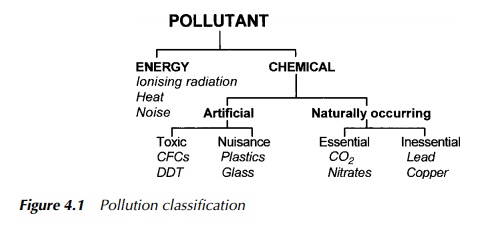Chapter: Environmental Biotechnology: Pollution and Pollution Control
Classifying Pollution - Environmental Biotechnology
Classifying Pollution
While, as we said earlier, this diverse nature of potential pollutants makes their systematisation difficult in absolute terms, it is possible to produce functional classifications on the basis of various characteristics. However, it must be clearly borne in mind that all such classification is essentially artificial and subjective, and that the system to be adopted will typically depend on the purpose for which it is ultimately intended. Despite these limitations, there is considerable value in having some method, if only as a predictive environmental management tool, for considerations of likely pollutant effect.
Classification may, for example, be made on the basis of the chemical or physical nature of the substance, its source, the environmental pathway used, the target organism affected or simply its gross effect. Figure 4.1 shows one possible example of such a categorisation system and clearly many others are possible.

The consideration of a pollutantÔÇÖs properties is a particularly valuable approach when examining real-life pollution effects, since such an assessment requires both the evaluation of its general properties and the local environment. This may include factors such as:
┬Ě toxicity;
┬Ě persistence;
┬Ě mobility;
┬Ě ease of control;
┬Ě bioaccumulation;
┬Ě chemistry
Toxicity
Toxicity represents the potential damage to life and can be both short and long term. It is related to the concentration of pollutant and the time of exposure to it, though this relationship is not an easy one. Intrinsically highly toxic substances can kill in a short time, while less toxic ones require a longer period of exposure to do damage. This much is fairly straightforward.
However, some pollutants which may kill swiftly in high concentrations, may also have an effect on an organismÔÇÖs behaviour or its susceptibility to environmental stress over its lifetime, in the case of low concentration exposure.
Availability also features as an important influence, both in a gross, physical sense and also in terms of its biological availability to the individual organism, together with issues of its age and general state of health. Other considerations also play a significant part in the overall picture of toxicity and we shall return to look at some of them in greater depth shortly.
Persistence
This is the duration of effect. Environmental persistence is a particularly important factor in pollution and is often linked to mobility and bioaccumulation. Highly toxic chemicals which are environmentally unstable and break down rapidly are less harmful than persistent substances, even though these may be intrinsically less toxic.
Mobility
The tendency of a pollutant to disperse or dilute is a very important factor in its overall effect, since this affects concentration. Some pollutants are not readily mobile and tend to remain in ÔÇśhot-spotsÔÇÖ near to their point of origin. Others spread readily and can cause widespread contamination, though often the distri-bution is not uniform. Whether the pollution is continuous or a single event, and if it arose from a single point or multiple sources, form important considerations.
Ease of control
Many factors contribute to the overall ease with which any given example of pol-lution can be controlled, including the mobility of the pollutant, the nature, extent or duration of the pollution event and local site-specific considerations. Clearly, control at source is the most effective method, since it removes the problem at its origin. However, this is not always possible and in such cases, containment may be the solution, though this can itself lead to the formation of highly concen-trated hot-spots. For some substances, the dilute and disperse approach, which is discussed more fully later, may be more appropriate, though the persistence of the polluting substances must obviously be taken into account when making this decision.
Bioaccumulation
As is widely appreciated, some pollutants, even when present in very small amounts within the environment, can be taken up by living organisms and become concentrated in their tissues over time. This tendency of some chemicals to be taken up and then concentrated by living organisms is a major consideration, since even relatively low background levels of contamination may accumulate up the food chain.
Chemistry
Pollution effects are not always entirely defined by the initial nature of the con-tamination, since the reaction or breakdown products of a given pollutant can sometimes be more dangerous than the original substance. This is of particular relevance to the present discussion, since the principle underlying much of prac-tical bioremediation in general involves the break down of pollutants to form less harmful products.
This is further complicated in that while the chemistry of the pollutant itself is clearly important, other substances present and the geology of the site may also influence the outcome. Accordingly, both synergism and antagonism are possible. In the former, two or more substances occurring together produce a combined pollution outcome which is greater than simply the sum of their individual effects; in the latter, the combined pollution outcome is smaller than the sum of each acting alone.
Related Topics